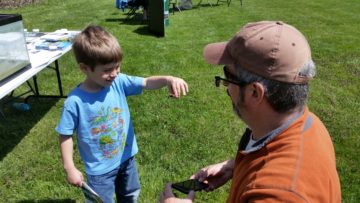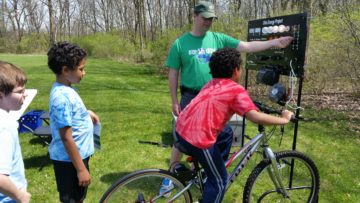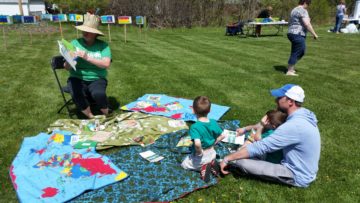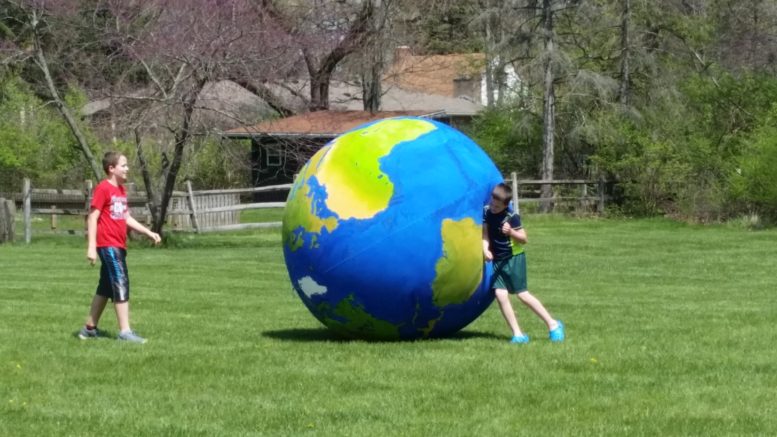By JAN LARSON McLAUGHLIN
BG Independent News
Bees get no respect.
Leeches may be ugly, but they are a sign of beauty to biologists.
And powering an incandescent light bulb takes a lot of energy from little legs.
An awful lot of learning was packed into fun hands-on (and feet-on) activities at the Seventh Annual Community Celebration of Earth Day on Sunday outside at the Montessori School in Bowling Green.
“We want people to have a greater appreciation of the local environment and also feel more connected with the planet,” said Caitlin Buhr, advancement director at the Montessori School. A lot of children have that bond with Mother Nature, she added. “We want to nurture the connection they already feel.”
The Earth Day celebration featured several different activity stations that snuck in learning for young children.

Boy shows off crayfish from Maumee River.
Children got to hold some critters like crayfish that came straight from the Maumee River near Otsego Park.
“Those critters can tell us a lot about the health of the river,” said Christina Kuchle, from the Ohio Department of Natural Resources. The sample in the aquarium was a pretty healthy mix of crayfish, mayflies, leeches, sow bugs, and freshwater shrimp.
The next station took children out of the water and lifted them skyward. Children could hear the calls of a bald eagle, California condor and Peregrine falcon, plus touch the skulls of several birds.
“Kids like anything hands on,” said Cinda Stutzman, of the Bowling Green Parks and Recreation Department.
Children put those hands to work at a station on bees, by splattering paint on paper flowers to pollinate them.
“Bees are often overlooked as a not important character because they are kind of scary,” said Jamie Justice, of a Bowling Green State University environmental studies class.
“Without bees, there won’t be any more plants,” Connor Phares said.
And that would have disastrous consequences. “It goes right up the food chain,” Justice said.

Energy bike powers electric appliances.
Children also got some painless lessons on energy conservation by riding the “energy bike,” from the city of Bowling Green. As they pedaled the bike, they found out how much energy it takes to operate different household items. Leisurely pedaling powered a small fan, radio and LED lights. But it took much more strenuous pedaling to turn on the incandescent lights, and even more to power the hairdryer.
“It’s trying to relay to folks about energy conservation,” said Jason Sisco, city engineer. “Your heart rate tells you pretty quickly the energy it takes for an incandescent light.”
Children also got to plant sunflowers, go fishing for pollution tips to help water quality, paint pet rocks, and make seed paper to plant when they got home. They pushed around a giant earth ball in an open field and took nature walks.
But in between the fun, some serious lessons were tucked in.
They learned that each person in the U.S. throws away about 20 pounds of food each month. They were showed the proper way to mow and wash cars so pollutants don’t make it into waterways.
They played a climate change trivia game that allowed some kids to show off their superior knowledge to their parents. They were quizzed on topics such as renewable energy and the impact of climate change.
“We’re trying to gauge if kids or adults know more,” said Matthew Cunningham, a BGSU environmental studies student. “Our past experience is that the children know more.”

Maria Simon reads story about planting trees.

